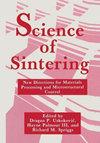Removal of the As(V) and Sr(VI) from the water using magnetite/3D-printed wollastonite hybrid adsorbent
IF 1.4
4区 材料科学
Q3 MATERIALS SCIENCE, CERAMICS
引用次数: 1
Abstract
In this study, the structure, morphology and composition of the synthesized magnetite/3D-printed wollastonite (3D_W/M) composite were characterized, and its adsorption performance with respect to As(V) and Cr(VI) were studied. Magnetite (MG) modified 3D printed wollastonite was obtained by two step procedure: modification of 3D_W with 3-aminoproylsilane (APTES) followed by controlled magnetite (MG) deposition to obtain 3D_W/M adsorbent. The structure/properties of 3D_W/M were confirmed by applying FTIR, XRD, TGD/DTA, and SEM analysis. The adsorption properties of hybrid adsorbents were carried out for As(V) and Cr(VI) removal - one relative to the initial pH value, the adsorbent mass, the temperature, and the adsorption time. Time-dependent adsorption study was best described by pseudo-second order equation, while Weber Morris analysis showed that intraparticle diffusion controled diffusional transport. Similar activation energy, 17.44 and 14.49 kJ?mol-1 for adsorption As(V) and Cr(VI) on 3D_W/M, respectively, indicated main contribution of physical adsorption. Determination of adsorption parameters was performed by applying different adsorption isotherm models, and the best fit was obtained using Freundlich model. The adsorption capacity of 24.16 and 29.6 mg g-1 for As(V) and Cr(VI) at 2?C, Co = 5.5 and 5.3 mg L-1, respectively, were obtained. Thermodynamic study indicated favourable process at a higher temperature. Preliminary fixed-bed column study and results fitting with Bohart-Adams, Yoon-Nelson, Thomas, and Modified dose-response model showed good agreement with results from the batch study.使用磁铁矿/ 3d打印硅灰石混合吸附剂去除水中的As(V)和Sr(VI)
本研究对合成的磁铁矿/ 3d打印硅灰石(3D_W/M)复合材料的结构、形貌和组成进行了表征,并对其对As(V)和Cr(VI)的吸附性能进行了研究。采用3-氨基丙基硅烷(APTES)对3D_W进行改性,然后控制磁铁矿(MG)沉积,得到3D_W/M吸附剂,制备了磁铁矿改性3D打印硅灰石。采用FTIR、XRD、TGD/DTA和SEM等分析手段对3D_W/M的结构和性能进行了表征。研究了混合吸附剂对As(V)和Cr(VI)的吸附性能——与初始pH值、吸附剂质量、温度和吸附时间有关。时间依赖吸附研究最好用拟二阶方程来描述,而Weber Morris分析表明颗粒内扩散控制扩散输运。相似的活化能,分别为17.44和14.49 kJ?mol-1在3D_W/M上分别吸附As(V)和Cr(VI),表明物理吸附的主要贡献。采用不同的吸附等温线模型确定吸附参数,Freundlich模型拟合效果最佳。对As(V)和Cr(VI)的吸附量分别为24.16和29.6 mg g-1。得到C、Co分别= 5.5和5.3 mg L-1。热力学研究表明,温度越高,反应越有利。初步的固定床柱研究结果与Bohart-Adams, Yoon-Nelson, Thomas和修正剂量-反应模型拟合的结果与批量研究的结果一致。
本文章由计算机程序翻译,如有差异,请以英文原文为准。
求助全文
约1分钟内获得全文
求助全文
来源期刊

Science of Sintering
工程技术-材料科学:硅酸盐
CiteScore
2.50
自引率
46.70%
发文量
20
审稿时长
3.3 months
期刊介绍:
Science of Sintering is a unique journal in the field of science and technology of sintering.
Science of Sintering publishes papers on all aspects of theoretical and experimental studies, which can contribute to the better understanding of the behavior of powders and similar materials during consolidation processes. Emphasis is laid on those aspects of the science of materials that are concerned with the thermodynamics, kinetics and mechanism of sintering and related processes. In accordance with the significance of disperse materials for the sintering technology, papers dealing with the question of ultradisperse powders, tribochemical activation and catalysis are also published.
Science of Sintering journal is published four times a year.
Types of contribution: Original research papers, Review articles, Letters to Editor, Book reviews.
 求助内容:
求助内容: 应助结果提醒方式:
应助结果提醒方式:


